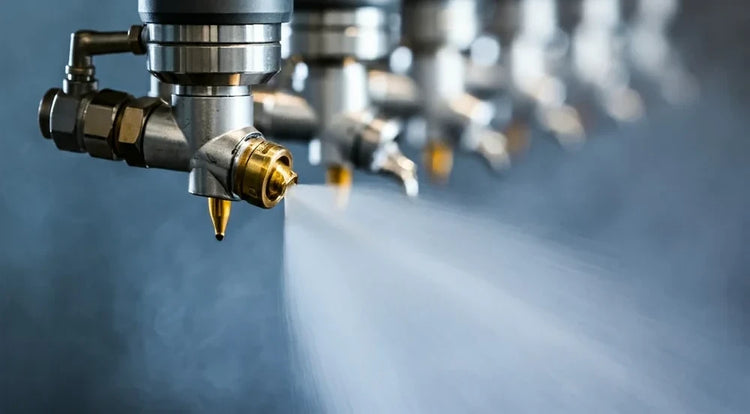Beginner's Guide to Industrial Spray Nozzles
Learn the fundamentals of spray patterns, nozzle types, and how to select the right solution for your application. Everything you need to know to get started.
Getting Started in 5 Steps
- Understand your application: What task are you trying to accomplish? (cleaning, cooling, coating, etc.)
- Identify the spray pattern: Does your process need a solid jet, flat fan, or cone spray?
- Consider flow rate requirements: How much liquid needs to be sprayed per minute?
- Evaluate operating pressure: What pressure range can your system support?
- Select and test: Choose a nozzle and refine based on results.
What Are Spray Nozzles?
Spray nozzles are precision devices that control how liquid is atomized and dispersed. They're the unsung heroes of industrial operations—from food processing lines to steel mills to chemical plants. The right nozzle transforms a simple liquid stream into a precisely controlled spray pattern tailored to your exact process needs.
At their core, nozzles work by taking pressurized liquid and directing it through carefully engineered orifices or passages. This creates specific spray patterns with controlled droplet sizes. The design of these internal passages—and whether air is involved—determines the spray pattern and performance characteristics.
Core Concepts You Need to Know
Spray Pattern
The shape and distribution of liquid as it exits the nozzle. Patterns include flat fan, cone, solid stream, and fog—each optimized for different tasks.
Flow Rate (GPM)
Measured in gallons per minute, this determines how much liquid the nozzle delivers. Larger orifices = higher flow rates at the same pressure.
Operating Pressure (PSI)
The force behind the spray. Higher pressure improves atomization and penetration, but increases wear and energy consumption.
Spray Angle
The width of the spray pattern, typically ranging from 15° to 120°. Wider angles cover more area but with less intensity.
Droplet Size Distribution
Finer droplets improve coverage and penetration but may drift. Larger droplets provide impact force but with less surface area.
Material Compatibility
Nozzles are made from stainless steel, brass, ceramics, or plastics depending on the liquid being sprayed and corrosion requirements.
The Six Main Spray Patterns
Each spray pattern excels at specific tasks. Understanding the differences helps you choose the perfect nozzle for your application. Shop our complete collection by pattern type.
Flat Fan
A narrow, sheet-like spray that delivers intense coverage in a concentrated line. Perfect for applications requiring strong impact and uniform wetting.
Best for: Washing, rinsing, conveyor cleaning, pressure washing, agricultural spraying
Flow Range: Low to medium
Coverage: Concentrated, linear pattern
Hollow Cone
A ring-shaped spray with a hollow center, producing ultra-fine droplets. Excellent for applications requiring even coverage with minimal waste.
Best for: Cooling, humidification, gas scrubbing, coating, dust suppression
Flow Range: Medium
Coverage: Circular with fine mist
Full Cone
A solid, circular spray with evenly distributed droplets throughout the pattern. Ideal for general-purpose industrial applications.
Best for: Chemical processing, dust suppression, fire protection, general cooling
Flow Range: Medium to high
Coverage: Full circular pattern
Solid Stream
A focused, high-impact jet that concentrates all liquid into a single powerful stream. Designed for cutting, descaling, and high-force cleaning.
Best for: Cutting, descaling, tank cleaning, pressure washing, debris removal
Flow Range: Medium to high
Coverage: Single concentrated jet
Fog & Mist
Creates ultra-fine droplets that form visible fog or mist. Perfect for humidity control and applications requiring minimal liquid volumes.
Best for: Humidification, odor control, dust suppression, cooling, greenhouse applications
Flow Range: Low to medium
Coverage: Fine mist suspension
Air Atomizing
Uses compressed air plus liquid for superior atomization control. Delivers the finest, most uniform droplets for sensitive applications.
Best for: Precision coating, sanitization, electronics, medical applications, controlled misting
Flow Range: Very low to medium
Coverage: Ultra-fine, uniform mist
Nozzle Types & Technologies
Different nozzle designs achieve their spray patterns through distinct mechanisms. Understanding these technologies helps you choose the right tool for your needs.
Axial-Flow Hollow Cone
Tangential-Flow Hollow Cone
Impact Flat Fan
Pressure-Swirl Full Cone
Jet Solid Stream
Air Atomizing
Spiral Nozzle
How to Select the Right Nozzle
Choosing the ideal nozzle involves evaluating your specific application requirements. Follow this decision framework to narrow down your options and find the perfect fit.
The Selection Process
Are you cleaning, cooling, coating, humidifying, or applying chemicals? Your primary task narrows down compatible spray patterns immediately.
How much liquid must be delivered per minute? Calculate based on tank size, cleaning time, or application area. This determines the nozzle capacity you need.
What pressure range can your pump or system support? Higher pressure improves atomization but increases equipment wear. Most industrial nozzles operate between 40-400 PSI.
Wide spray for broad coverage? Narrow jet for precision? Solid impact or fine mist? Your coverage needs determine which pattern family to explore.
What liquid are you spraying? Corrosive chemicals require stainless steel or ceramic. Water might allow brass. Abrasive slurries demand hardened materials.
How often will you clean or service the nozzle? Spiral designs resist clogging. Simple jet designs require minimal maintenance. Your operational environment matters.
Order a sample nozzle and test it in your actual operating conditions. Real-world performance often reveals details that calculations miss. Use our nozzle search to find options.
Common Industrial Applications
See how different industries leverage spray nozzles to improve efficiency and quality.
Food & Beverage
Sanitation, cooling of products during processing, hygiene rinse systems. Nozzles must comply with food-grade materials and facilitate CIP (Clean-In-Place) protocols.
Automotive
Parts washing, paint application, coolant delivery. Requires precise spray patterns for even coating and efficient cleaning in assembly line environments.
Chemical Processing
Liquid blending, cooling reactions, dust suppression, vessel cleaning. Nozzles must resist corrosion and handle aggressive chemical formulations.
Steel Manufacturing
Cooling hot steel, descaling, dust control. Industrial nozzles handle extreme temperatures and abrasive conditions with ceramic or hardened materials.
Wastewater Treatment
Aeration, scrubbing, sludge processing. Robust spiral designs prevent clogging in harsh, debris-laden environments.
Agriculture
Pesticide application, irrigation, dust control. Flat fan nozzles provide efficient coverage with minimal drift and product waste.
Why Proper Nozzle Selection Matters
Operational Efficiency
The right spray pattern reduces liquid waste, covers target areas faster, and minimizes rework or respraying. Over time, this compounds into significant cost savings.
Superior Quality
Consistent droplet size and spray distribution improve product quality—better coatings, cleaner surfaces, more uniform cooling. Quality compounds customer satisfaction.
Safety & Compliance
Optimized sprays reduce overspray, airborne particulates, and cross-contamination. This lowers worker exposure risks and helps meet environmental regulations.
Reduced Operating Costs
Efficient nozzles lower consumption of water, chemicals, energy, and compressed air. Maintenance costs drop with designs resistant to clogging and wear.
Equipment Longevity
Matching nozzles to your system pressure prevents unnecessary strain on pumps and lines. The right pressure-flow combination extends equipment lifespan significantly.
Process Reliability
Industrial-grade nozzles designed for your specific conditions mean fewer unexpected failures, less downtime, and more predictable operations.
Frequently Asked Questions
What's the difference between PSI and GPM?
PSI (pounds per square inch) is the pressure behind the spray—the force. GPM (gallons per minute) is the flow rate—how much liquid is delivered. Think of pressure as the power and flow as the volume. You need both properly configured for your nozzle to perform optimally. Higher pressure generally improves atomization, while higher flow delivers more liquid per minute.
Can I use a nozzle designed for one pressure at a different pressure?
Generally, it's not recommended. Operating outside the designed pressure range compromises performance. Too low and the spray pattern deteriorates. Too high and the nozzle wears quickly or delivers unpredictable results. Always check the manufacturer's specifications and stay within the recommended pressure range.
How often should I replace nozzles?
Lifespan depends on usage, liquid type, pressure, and material. In harsh conditions with abrasive slurries, you might replace quarterly. In gentle applications with clean water, they could last years. Monitor for wear, clogging, and performance degradation. When spray pattern or flow changes noticeably, it's time to replace.
Why do some nozzles clog easily?
Particulates, mineral deposits, or chemical residues can block the orifice. Simple designs with small orifices are more prone to clogging. Spiral nozzles resist clogging because they have larger internal passages. For applications with particulates, choose designs with proven clog resistance or install upstream filtration.
What material should I choose for my nozzle?
Stainless steel resists corrosion and works with most liquids. Brass is cost-effective for water-only applications. Ceramics handle abrasive slurries. Plastics work for low-pressure, non-aggressive applications. Match material to your specific liquid and operating conditions to maximize nozzle life.
How do I calculate the right nozzle size?
Start with your required flow rate (GPM) and operating pressure (PSI). Most nozzles have published flow charts showing GPM at various pressures. Find the nozzle size that delivers your desired flow at your system pressure. Then verify the spray pattern matches your application needs. Our selection guides walk through this process step-by-step.
What's the benefit of air-atomizing nozzles?
Air-atomizing nozzles use compressed air to atomize liquid, creating extremely fine, uniform droplets with minimal flow rate needed. They excel for precision coating, sanitization, and applications requiring excellent control. The tradeoff is higher complexity and the need for clean compressed air. Explore air atomizing options.
Can spray nozzles be customized?
Yes. Many manufacturers offer custom designs for unique requirements—unusual spray angles, specific flow rates, specialized materials, or particular connection types. Custom nozzles typically require minimum orders and longer lead times, but solve otherwise impossible application challenges. Contact our team to discuss custom options.
Ready to Find Your Ideal Nozzle?
Browse our complete product catalog, use our interactive selector tool, or contact our spray experts for personalized guidance.
Explore All NozzlesContinue Learning
Dive deeper into specific spray patterns, nozzle types, and industry applications with our comprehensive resource library.
Flat Fan Spray Nozzles
Complete collection and guide to flat fan patterns, applications, and performance optimization
Hollow Cone Spray Nozzles
Full overview of hollow cone technology and cooling applications
Full Cone Spray Nozzles
Full cone patterns for chemical processing and dust suppression
Air Atomizing Nozzles
Precision atomization for coating and sanitization applications
All Spray Patterns
Complete browsable collection of all nozzle types and spray patterns
Resource Center
Browse our complete library of guides, articles, and technical documentation

